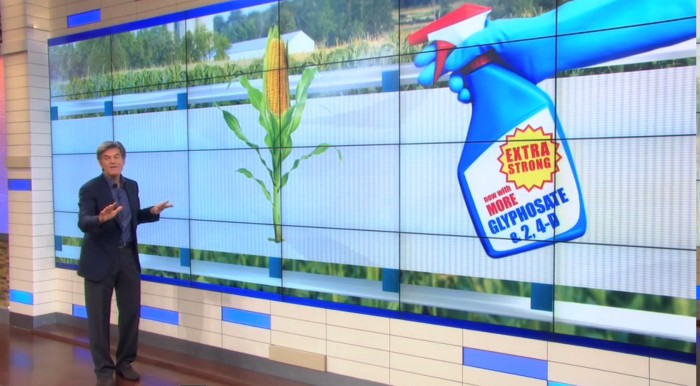Written by Steve Savage

Television personality Dr Oz has released a video which talks about an agricultural product called Enlist Duo. Virtually nothing in this video is presented accurately. It is a prime example of fear-mongering around the issues of “GMOs” and pesticides. I’d like to respond, point by point, to what it says that is not true or misleading.
Dr Oz’s statements/image descriptions will be in red:
“The EPA is on the brink of approving a brand new toxic pesticide you don’t know about.”
The product in question, Enlist Duo is a combination of two very old herbicide products: 2,4-D and glyphosate. A great many consumers do know about these materials because they have been approved for homeowner use for decades and are common ingredients in products available at any neighborhood gardening center. These chemicals are still approved for use in more than 70 countries around the world and for use in high exposure settings like lawns, parks, sports fields and gardens. They are still used this way because after multiple rounds of increasingly sophisticated scrutiny by regulators, they have been confirmed to be quite low in toxicity to humans and to the environment. This product is neither “brand new” nor is it notably “toxic.”
These products are for new GMO corn and soy crops that “survive even stronger pesticides.”
What does “stronger pesticide” mean? The need for this mixture is that some weeds have evolved resistance to glyphosate. There is nothing unique about that associated with a biotech crop. Weeds have evolved resistance to all manner of control methods including mechanical tillage (some weeds like bindweed or Canada thistle are very well adapted to being chopped up and spread around a field by equipment). The issue isn’t about something “stronger” but about something that is a mixture of two distinct “modes of action” which makes it harder for the weeds to adapt around the control. The term “stronger” that Oz uses implies something about being more toxic or dangerous. That is not the case here.
This product includes “2,4-D a chemical used in Agent Orange which the government banned during the Vietnam War.”
As I have written before, this Agent Orange allusion is a callous exploitation of a real human tragedy. The horrible health effects of that material were eventually found to have been caused by an unrecognized dioxin contaminant in one component of the herbicide mix, 2,4,5-T. It never was associated with the 2,4-D. As you can imagine, while all of this was being sorted out, 2,4-D was intensively scrutinized. The fact that it remains so widely approved around the world is only because its safety was confirmed in all these regulatory reviews.

These GMO crops (resistant to both herbicides) are “ushering in a pesticide arms race and the health of your brain could be the casualty.”
Again, the people who have been growing food for millennia have been fighting weeds and their ability to adapt to whatever methods we use to control them. Unless Dr Oz has some alternative suggestion, perhaps he should leave the topic of weed control to people who actually do this for a living and for our benefit. Now as for the “health of your brain…”
“More than 1/2 million people wrote to the EPA” about this pesticide approval “including a letter signed by 35 prominent doctors, scientists and researchers” who raised concerns about “non-hodgkins lymphoma, Alzheimers and Parkinson’s disease.”
When a regulatory agency like the EPA or USDA has an open comment period about a pending decision, what they are looking for are relevant issues from a science point of view. Its not about numbers of comments or whether the submitters are “prominent.” The “35 prominent” signatories Oz describes are well known, perennial anti-GMO advocates. If they had raised real health issues, the agency would have responded, but repeated and detailed risk analysis has never established a connection between these herbicides and human health issues.
“How concerned should you be about this product that could come to a farm near you?”
The image during this part of the video is of bell peppers and other such crops which have never been contemplated for the use of this technology. Throughout the video the images are mostly of crops and foods that have nothing to do with this product. The crops in question (as Oz himself says earlier) are corn and soybeans – crops mainly grown in regions far removed from Dr. Oz’s viewer-base. Even so, the “crops” nearest most of this audience would be their own lawns or their neighbor’s lawns, or the neighborhood park or sports field. These chemicals have been used there for decades. This is in no way a new threat in the context of the average American life.
“70-80% of the food we eat today contain GMOs.”
“GMO” is a meaningless term because essentially all crops have been “genetically modified” in some way throughout human history. That is why most of them are suitable for human consumption. There are ingredients in something like 70% of processed foods which originate from crops that have been improved via biotechnology. There is nothing in those ingredients that is dangerous and in most cases there is not even anything related to the one or two genes that were different in the source plant. Animals around the world have been eating these crops for feed for nearly two decades without any ill effects. Oz clearly makes this statement to sound ominous – but there is no basis for such a concern.
If this product is approved, “70 to 100 million pounds of additional, highly toxic pesticides will be used.”
OK, lets put this in a little perspective. Between corn and soybeans there are more than 150 million acres in the US, so the number Oz throws out represents less than a pound per acre. Herbicides were used on these crops long before biotech so this use isn’t really “additional.” Also, the term “highly toxic” simply does not apply to these materials from a human perspective.
At the end of this video clip, Oz speaks with a “concerned mom” who gives an anecdote about the improved health of her children after she switched to a “GMO-free diet” and “organic to avoid pesticides.”
First of all, one could find any number of anecdotal examples of families (like mine) that never made such a dietary choice, yet who never experienced the sort of health issues this mother described. Second, by choosing organic she was not avoiding pesticides at all. There are pesticides legally used on organic crops and there are often residues of other pesticides there as well. Abundant data demonstrates the fact that most Americans would be best off to eat more fruits and vegetables because the benefits vastly outweigh any potential risks associated with pesticides.
Dr Oz may be an entertainer, but he is also in the fear business and in the supplement business – either directly or based on the sponsorship he gets because he can find an audience for these messages. Oz normally gets by with this; however, he has been called on the carpet by Congress for some of the magical claims he has supported for certain weight reduction supplements. I’m sure that Oz will have successfully frightened a huge number of people with this video. I’m sure that will help drive his viewership and thus his sponsorship income. Unfortunately, society as a whole is worse off for the spread of this sort of disinformation.
Written by Guest Expert
Steve Savage has worked with various aspects of agricultural technology for more than 35 years. He has a PhD in plant pathology and his varied career included Colorado State University, DuPont, and the bio-control start-up, Mycogen. He is an independent consultant working with a wide variety of clients on topics including biological control, biotechnology, crop protection chemicals, and more. Steve writes and speaks on food and agriculture topics (Applied Mythology blog) and does a bi-weekly podcast called POPAgriculture for the CropLife Foundation.






